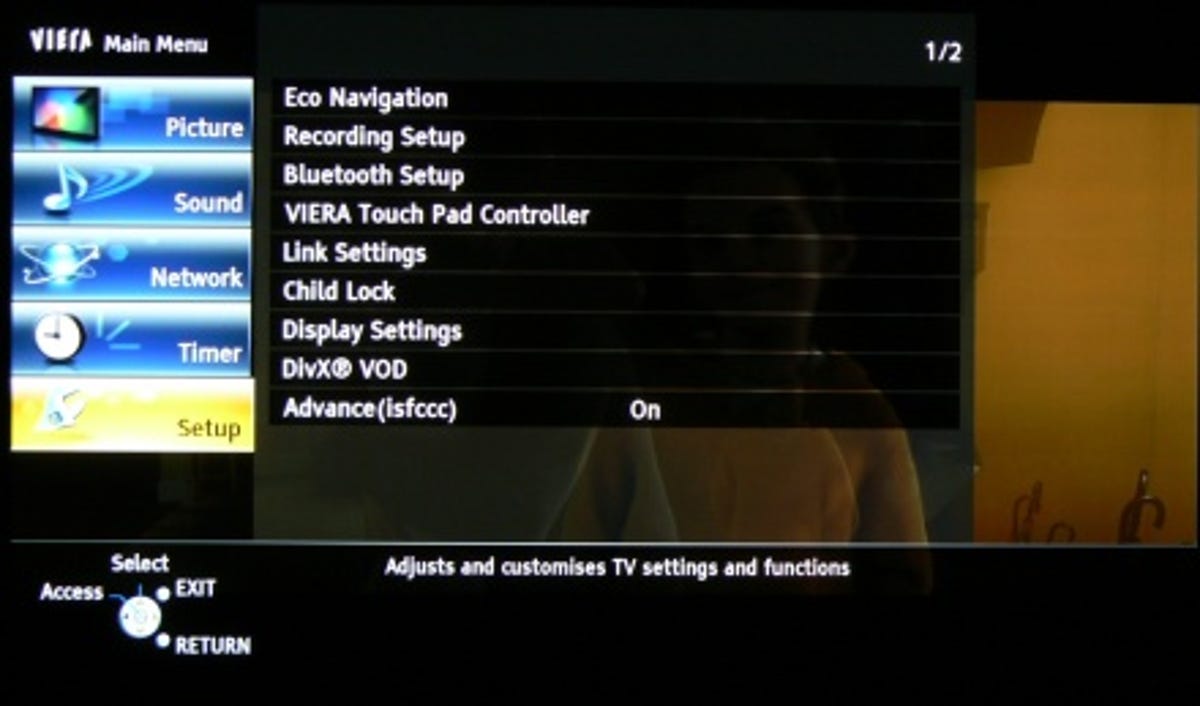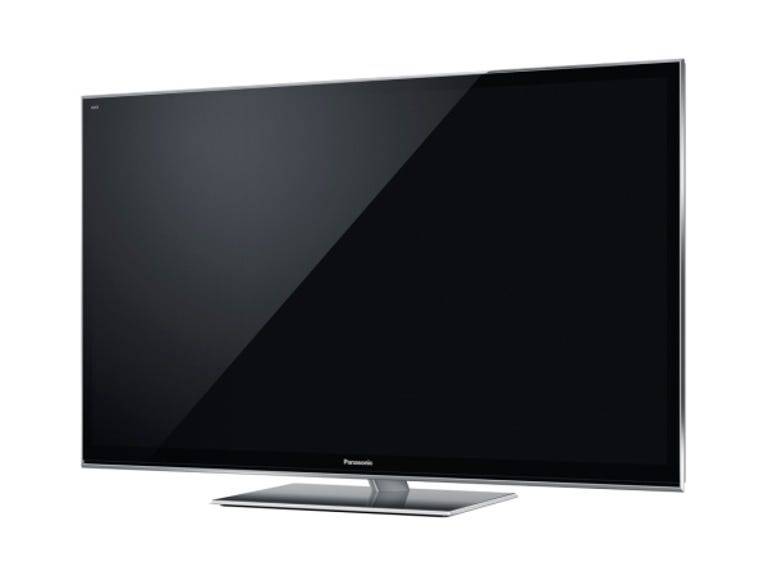 Why You Can Trust CNET
Why You Can Trust CNET Panasonic TX-P50VT50B review: Panasonic TX-P50VT50B
The stunning 50-inch Panasonic TX-P50VT50 produces possibly the best pictures I've seen but the very similar TX-P50GT50 is £500 cheaper.
If there's one series of TVs that AV enthusiasts have taken to their hearts almost as dearly as Pioneer's old Kuro range, it's Panasonic's premium VT models. Over the last few years, these sets have consistently produced class-leading black levels and colour performance. This is perhaps not that surprising as Panasonic bought many of Pioneer's Kuro-related patents and gradually integrated them into its TVs.
The Good
The Bad
The Bottom Line
The latest Viera VT50 plasma is available in 50, 55 and 65-inch screen sizes, and here I'm looking at the smallest of the three models. It competes directly with Panasonic's cheaper TX-P50GT50B, so is there enough on offer to make it worth the premium over that model?
It can be bought for around £1,900.
User interface and EPG
Panasonic's menu system is best described as basic looking. Unfortunately, the company hasn't updated the design and layout for a few years and it's beginning to look quite dated, especially when compared to the attractive and dynamic menus that Samsung and LG are using on their sets.

This may not bother a lot of users, but I personally find it disappointing that a TV that's so advanced in other ways is lumbered with menus that look unchanged from the 16-bit era of home computing. On the plus side, their simplicity makes them fairly quick and easy to navigate and Panasonic provides you with advanced controls for tweaking stuff like picture options.
The advert place holders that used to blight the electronic programme guide (EPG) on its older sets have finally been removed, and the layout has been cleaned up to make it more attractive. In fact, there are three EPG layouts for you to select via the main menu. They're not massively different from one another, but they do offer a choice of info views and numbers of channels shown on screen.
Sadly, because the EPG doesn't overlay on top of the video feed and doesn't have a video thumbnail window, you lose all pictures and audio from the programme you're watching when you call it up. As Panasonic's own personal video recorders now have a thumbnail view in the EPG, I don't see why the company can't add one to this TV, especially as it's essentially Panasonic's flagship model.
Internet features and video playback
Like the other higher-end models in Panasonic's current range -- the GT50 and WT50 -- this TV uses a dual-core processor to power the smart TV features. This brings two advantages. Firstly, apps are quicker to start up and slightly smother to use -- although the difference isn't massive over the company's single-core models. Secondly, and perhaps more appealing, is the fact that it allows the TV to multi-task with smart apps, so you can have a number of apps running in the background.
To switch between the apps, you press the Viera Tools button on the remote and the corner of the screen curls up to show the apps running in the background.
Changing between the last two opened apps is almost instantaneous, but switching to a third app isn't quite as fast. It's still quick, but it seems to me that the TV only runs two apps in the background and suspends all the others to memory. Hence the reason why there's a slight delay when you switch to the third or fourth app in the list.
Like the main menus, the interface for Panasonic's Viera Connect Smart TV platform could do with an update, not just to make it look more contemporary, but also to speed up navigation. Panasonic is currently using a layered system where apps are arranged on grids and then stacked on top of each other across different screens. The problem is that the more apps you load, the more layers you need to wade through to get at the apps you want to use. You can rearrange the order of the apps to group commonly used ones on the same page, but it's not an ideal system.
That said, the range and quality of the apps available is good. Along with the obligatory iPlayer and YouTube apps, you get support for Netflix as well as the Acetrax and FetchTV services. You can access the Dailymotion and Vimeo video clip services. And there are standalone Twitter and Facebook apps, as well as a combined Social Networking widget that overlays feeds from these two social networks over the TV show you're watching.
This model has a full web broswer on board and you can use Panasonic's free Android and iOS apps to 'catch and throw' websites from you phone or tablet to the TV. However, navigating sites using the remote -- even the touchpad one -- is fairly slow. On the plus side, it does support Adobe Flash, so you can play most videos on websites, although full-screen playback doesn't seem to be possible.
Naturally, this model supports digital media playback. Panasonic has greatly improved the format support compared to last year's VT30. I found it would now happily stream HD MKV and DivX files from my NAS drive. It also worked a treat with files held on USB memory keys and SD cards.
Design and connections
Panasonic isn't exactly known for its stylish TV designs, with previous models looking rather staid compared to its rivals. However, things are definitely changing on this front and the VT50 benefits from the improvements. Due to the nature of plasma technology, these sets are never going to have the bezel-free look of the latest LG and Samsung LED TVs. Neither will they be as slim. But with a panel depth of just 43mm, the VT50 is thin by plasma standards and its bezel is both narrow and beautifully framed by a classy-looking chrome strip.
The remote has been redesigned slightly. The button layout and shape remain largely unchanged, which is a positive as all the key buttons are sensibly placed. The remote now has a glossy finish to better match the high-end styling of the TV. Panasonic also supplies a secondary touchpad controller, but I can't say I'm a fan of it as I found it quite cumbersome to use. I doubt many people will prefer it over the standard zapper.
You'd expect a flagship TV to have an abundance of ports and the VT50 doesn't disappoint. The TV's four HDMI inputs are positioned on the left-hand edge of the set. Sitting above these you'll find three USB ports, as well as the SD memory card reader and CAM slot.
The rest of the connections are found on a downward-facing panel on the rear. This is home to both the RF input for the Freeview HD tuner, as well as the F-connector for the Freesat HD tuner. Wi-Fi is now built in and there's an Ethernet port if you'd prefer to use a wired connection. This panel also has mini-jack inputs for the component and Scart breakout cables, as well as an optical audio output.
Audio quality
Some of Panasonic's latest TVs have been somewhat iffy when it comes to audio (the ET5 series, I'm looking at you). The VT50, on the other hand, is actually quite meaty when it comes to sonics.
This is partly due to the fact Panasonic has integrated a small 80mm woofer into the rear of the set. This really helps it add extra low-end thump when you're watching a movie, making it sound much more bassy than most of its LED rivals.
2D picture quality
You can sum up the VT50's 2D picture performance in one word -- awesome. It produces the deepest black levels I've ever seen from a TV. Unlike LED models that use tricks like local dimming to increase the depth of their blacks -- something that generally leads to haloing, light pooling and other backlight inconsistencies -- the VT50 doesn't have to use any of these gimmicks. Its blacks are consistent right across the display.
This set has finer gradient control than the cheaper GT50 model, and while the differences are subtle, it does have slightly more refined handling of detail in dimly-lit scenes. That's saying something as the GT50 is no slouch in this area.
Motion clarity is fantastic, achieving levels of smoothness and crispness that most other TVs could only dream of. Fast-paced sports like football and F1 are a pleasure to watch.
Handling of colour also seems much improved from previous models. Graduations between colours are extremely smooth and natural and hues have a lot of punch, while retaining their warmth and naturalness.
Panasonic says the VT50's panel is brighter than that used on last year's models. To my eyes, there isn't a massive difference. It's still capable of producing very bright images by plasma standards, but it's a long way off what today's LED screens are capable of. Because of this, the VT50, as with most plasmas, is not the ideal choice if you tend to watch TV either during daylight hours or with very bright lights in your room. Other than that, there's little to fault with its 2D picture quality.
3D picture quality
Unlike the GT50, Panasonic ships the VT50 with two pairs of 3D glasses included. By the usual standards of active 3D specs, these are actually very light and relatively comfortable to wear.
The set's 3D pictures are strong. Panasonic's plasmas have traditionally offered up some of the most crosstalk-free 3D pictures you'll find on any TV. Thankfully, that trend continues on the VT50. In fact, it performs so well that for all intents and purposes, images are almost completely free of crosstalk (where there's ghosting of images). The active 3D pictures look sharp and the sense of depth is very believable, helping to suck you into the 3D experience.
On the negative side, the dimming effect of the active glasses, and that fact that plasma screens are inherently less bright than LED screens, means 3D images do look quite a lot darker than on the majority of LED sets. That's particularly noticeable if you're watching 3D material during the day.
Conclusion
There's no doubting the TX-P50VT50B is a stunning TV. It offers arguably the best picture quality of any set on the market today, has good audio quality, a sterling line-up of smart TV apps and an attractive design. The problem is that the differences with the TX-P50GT50B are relatively small, yet there's a huge £500 hike in price. This is actually one of the reasons why Panasonic doesn't offer the GT50 in screen sizes over 50 inches -- to avoid the two competing with each other at the very top of the market.
If you're a picture quality purist and have money to burn, by all means go for the VT50, as it's the best TV out there at the moment. But for the vast majority of people buying a 50-inch screen, the excellent GT50 is the better option.


